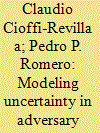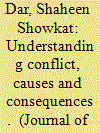| Srl | Item |
| 1 |
ID:
101614


|
|
|
|
|
| Publication |
2010.
|
| Summary/Abstract |
Past studies examining the international conflict behavior of parliamentary democracies have reported inconsistent findings and produced some empirical puzzles. One of the main puzzles is that, despite a strong theoretical basis for expecting coalitional majority cabinets to be less conflict prone than single-party majorities, most studies found no difference in their conflict behavior. Still others report coalitional governments to be more conflict prone than single-party ones. In this study, I show that these empirical inconsistencies can be resolved once we take into account the ideological composition of the cabinet. The main contention is that relatively marginal coalitional partners may have a disproportionate influence when the government faces risky decisions, such as the initiation of international disputes. The key lies in their greater bargaining leverage in intra-coalitional politics, which is subsequently reflected in their influence over foreign conflict decisions. More generally, this study shows how different degrees of ideological diversity or cohesion abate and/or accentuate a state's conflict behavior. The expectations are tested empirically, and the findings more robustly predict the conflict behavior of parliamentary regimes than do the results of previous research.
|
|
|
|
|
|
|
|
|
|
|
|
|
|
|
|
| 2 |
ID:
087397


|
|
|
|
|
| Publication |
2009.
|
| Summary/Abstract |
Uncertainty is a hallmark of conflict behavior, and other forms of violence that accompany civil and international war-such as low-intensity warfare, guerrilla, insurgency, and asymmetric conflict-are no exception. This study applied the theory of political uncertainty and complexity theory to the analysis of conflict events during the first three years of the second Iraq war, 2003-2006, limited to the Diyala province. Findings show that neither the time between attacks T or the severity of attacks S (fatalities) have the "normal" (bell-shaped) or lognormal distribution that is characteristic of equilibrium systems. Instead, both variables showed heavy tails, symptomatic of non-equilibrium dynamics, in some cases approximating a power law with critical or near critical exponent value of 2. The empirical hazard force analysis in both cases showed that the intensity was high for the first epoch in both variables (March 2003 to June 2004) but even higher in the latter period from July 2004 to March 2006. Selected policy implications are discussed, including the possibility that real-time or near real-time analysis of the data analyzed through the uncertainty-complexity computational methods would have revealed the gathering momentum of adversarial attacks perhaps in time to have prevented the insurgency.
|
|
|
|
|
|
|
|
|
|
|
|
|
|
|
|
| 3 |
ID:
127418


|
|
|